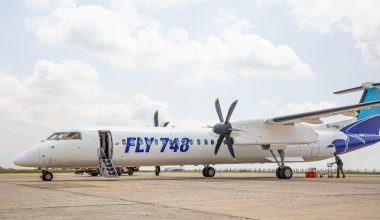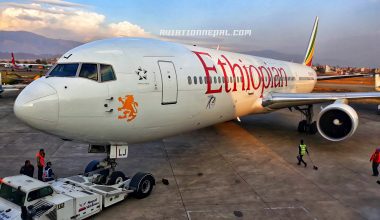Ethiopian Airlines is set to receive delivery of its new Airbus A350-900 at the end of this month. The new widebody twin-engine airliner marks the 19th aircraft in the Ethiopian fleet. Currently, Ethiopian Airlines has 18 A350-900s in service and a backlog of two A350-900s and four A350-1000s. In July, the state-owned carrier converted some of its undelivered A350-900 aircraft to the technologically advanced Airbus A350-1000s. This makes Ethiopian Airlines the first African airline customer for the A350-900s and the largest Airbus variant, the A350-1000s.
In a bid for fleet expansion, Ethiopia’s flag carrier will make a final decision in the first half of 2023. The airline CEO Mesfin Bekele informed that they are evaluating Airbus A220 and Embraer 195E2 for the 100-seater market. Ethiopian Airlines plans to up its fleet by purchasing new regional jets and more wide bodies. Currently, the carrier boasts an industry-leading fleet of over 135 aircraft, comprising all ultra-modern and environmentally friendly jets.

Furthermore, Ethiopian Airlines continues to excel in commanding the lion’s share of the Pan-African network. The airline has succeeded in passenger and cargo operations with unique agility and unrivaled efficiency. In 2022, Ethiopian Air Lines marked its presence in destinations like Bulawayo, Zurich, Amman, Chennai, Lome, Bengaluru, etc. Through continuous changes and investment in customer service, the carrier seeks to cement its position as the world’s leading airline.
Background of Ethiopian Airlines
The Addis Ababa-based Ethiopian Airlines (ET) is a state-owned flag carrier of Ethiopia founded on December 21, 1945. It concentrates traffic flow through its fortress hub in Addis Ababa and secondary hub in Lome-Tokoin Airport. It is Africa’s largest, fastest-growing, and best airline owing to its unparalleled efficiency and relentless push for excellence. The carrier has an enviable fleet size, passenger numbers, revenue, and destination networks, larger than any African carrier. Moreover, in terms of the nations served, it is the fourth largest carrier in the world, with a presence in over 80 countries. It has been a Star Alliance member since 2011 and offers seamless passenger travel to over 1000 airports through codeshare agreements.

Ethiopian Airlines fleet 2022
As of 2022, Ethiopian Airlines’ fleet consists of 130+ fuel-efficient aircraft belonging to Airbus, Boeing, and De Havilland companies. Touting one of the youngest fleets in the industry, Ethiopian operates different types of aircraft based on destinations and operations.
The carrier has a regional fleet of 33 De Havilland Canada DHC-8-400s to serve the domestic passenger market. Powered by PW150A-turboprop engines, Q400s carry 78 passengers (7 Cloud Nine and 64 Economy seats) on domestic routes. In coming years, Ethiopian Airlines seeks to incorporate new jets on the narrow body side for the 100-seater market.
For ultra-long-range routes, Ethiopian deploys aircraft like Airbus A350-900 XWB, Boeing 787-8s, Boeing 787-9s, Boeing 777-300ERs, B777-200LRs, and B767-300ERs. Ethiopian Airlines is yet to receive 2 A350-900s as it enjoys A350s’ unbeatable operational flexibility, fuel efficiency, and unrivaled levels of operational reliability. Ethiopian’s widebody A350 fleet connects Addis Ababa to the carrier’s long-haul destinations in Africa, Europe, the Middle East, and Asia. These flying birds accommodate 30 business class and 313 economy passengers in spacious, quiet cabins with mood-lighting features.
Likewise, its fleet of 20 Boeing 737-800s, 8 B737 Max, and 9 B737-700NGs serve the role of medium-range passenger services. These jets carry 118-170 passengers in a single-aisle configuration.
In addition to dominating the passenger skies, Ethiopian Airlines is a leader in cargo operations. It makes big bucks from cargo and has a strong footprint in the African freighter market. It has designated 9 B777-200LRFs, 4 Boeing 737-800Fs, and 1 B767-300Fs to perform cargo and non-scheduled services.
To satisfy ever-increasing customer demand in a vast global network, Ethiopian Airlines has placed an order for several aircraft, including 4 Airbus A350-1000s, 2 Boeing 787-9s, 5 Boeing 777-200LRFs, and 22 Boeing B737 Max 8s. The largest A350 variant, A350-1000s, will be influential in increasing the East African carrier’s capacity and advancing sustainable goals. Powered by Rolls-Royce Trent XWB engines, the eco-friendly A350-100s offer a 25% reduction in fuel burn and CO2.
Ethiopian Airlines flights: destinations served
If you are looking for Ethiopian Airlines flights, you’ll be thrilled to see its vast worldwide network across five continents. As an anchor airline, the carrier reaps the benefit of Addis Ababa’s strategic location to strengthen its foothold in Africa, Europe, the Middle East, and the Far East.
Addis Ababa Bole International Airport (ADD) is a global aviation hub and the largest aerial gateway to the ‘Dark Continent.’ Located in Ethiopia’s capital, it serves as the most renowned gateway between Africa and the rest of the world. As the primary hub of Ethiopian Airlines, the airport promises hope for the future of the Ethiopian aviation sector.
The national airline links Africa to Asia, Europe, the Middle East, and North America through its main base at ADD. Within the country, Ethiopian Airlines operates passenger flights to Arba Minch, Asosa, Axum, Awasa, Bahar Dar, Dembidolo, Dessie, Dir Dawa, Gambela, Goba, Gode, Gondar, Humera, Jiiga, Jimma, Kebri Dahar, Lalibela, Mekele, and Semera.
Ethiopian airline has the largest African network, including Coromos (Moroni), DR of the Congo (Goma, Kinshasa, Lubumbashi), Egypt (Cairo), Eritrea (Asmara, Assab, Massawa, and Teseney), Kenya (Mombasa, Nairobi), Malawi (Blantyre, Lilongwe), Nigeria (Abuja, Enugu, Kano, Lagos), Somalia (Bosaso, Garowe, Hargeisa, and Mogadishu), South Africa (Cape Town and Johannesburg), South Sudan (Juba), Sudan (Khartoum), Tanzania (Dar es Salaam, Kilimanjaro, Zanzibar), Zambia (Livingstone, Lusaka, Ndola), and Zimbabwe (Harare, Victoria Falls).
The government-run Ethiopian Airlines serves the North American countries of Canada, Mexico, and the United States of America. You can easily book ET’s flights to US cities like Chicago, Newark, New York, and Washington, DC. Likewise, in South America, ET flies to Argentina, Brazil, Chile, Columbia, etc.
While discussing ET’s European network, the carrier conducts passenger operations to Belgium, Cyprus, France, Germany, Greece, Luxembourg, Netherlands, Norway, Portugal, Russia, Spain, Switzerland, Sweden, Turkey, and the United Kingdom.
Similarly, Ethiopia’s Asian network includes countries like China, India, Hong Kong, Indonesia, Japan, Malaysia, Singapore, South Korea, and Thailand. Furthermore, it operates scheduled passenger service to the Middle Eastern countries of Qatar, Kuwait, Oman, Saudi Arabia, and the UAE.
The financial success of Ethiopian Airlines
For a sector known for financial instability, Ethiopian Airlines has set an example by earning profits almost every year. In its 75 years-long flight history, the carrier has soared to greater heights as one of the most financially successful airlines in the world. While other carriers struggle to earn even in the best of times, this flagship airline finished 2020FY with a profit.
As we all know, 2020 was the darkest period for the aviation industry due to the global health crisis worldwide. Passenger demand plunged, revenue dwindled, and many carriers filed for bankruptcy. The coronavirus pandemic wasn’t a stranger to ET; like any other airline, 90% of its passenger fleet was grounded. Yet, it succeeded in staying in the black by using diversification strategies and agile management’s help. The carrier transitioned its focus to cargo operations and converted its passenger aircraft to freighters for medical supplies transportation.
As per the financial report published by the state-owned carrier on August 31, 2022, it stayed cash positive. It boosted its profitability by 90% from the last year to an impressive $937 million. In the pandemic-battered world, the carrier achieved 79% growth compared to 2021 by drastically reducing operational costs. It saw a 36% growth in passenger volume and achieved significant gains in the cargo sector.
The strong revenue performance of Ethiopian Airlines for almost all years of operations can be attributed to three major factors. The strategic geo-position of Ethiopia between South Asia, the Middle East, Europe, and Asia, competent leadership and progressive business strategies, and the ability to evolve to the ever-changing demands of customers are some of the reasons behind the excellent financial outcome of Ethiopian Airlines. Although it is 100% owned by the government, it strives to achieve excellence with agility and resilience in tough conditions. Besides, the Ethiopian government gives a certain degree of independence in its daily operations and deep protection by limiting the services of other carriers inside the country.
Is Ethiopian Airlines a good airline?
Africa’s leading carrier, Ethiopian Airlines, is the best airline in the continent regarding customer service, the destination network, and onboard services. Certified as a 4-star airline by Skytrax has redefined end-to-end passenger experience by keeping itself abreast of new aviation technologies. Ethiopian airline operates an innovative and technologically-advanced aircraft fleet to ensure passenger comfort and environmental sustainability.
The onboard product of Ethiopian Airlines is excellent as well; Cloud Nine (business class) cabins feature state-of-the-art seats and elaborated inflight service with warm Ethiopian hospitality. Economy passengers enjoy comfortable seats, individual attention, the latest in-flight entertainment options, and Ethiopian national dish. Depending on the flight, the carrier offers light snacks to full-course hot meals to passengers on board the main cabin.






